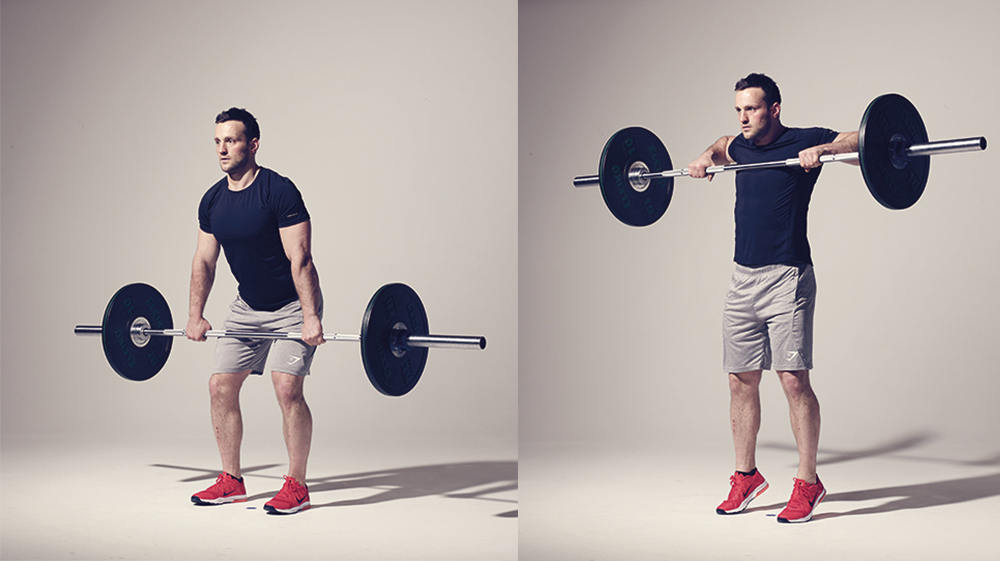How To Do The High Pull
Work on your shoulders and your posture in one fell swoop with the high pull

The high pull may look similar to the upright row, but it is an entirely different beast. In fact, this compound exercise has much more in common with Olympic lifts than with the upright row.
That’s because the high pull incorporates all your major muscle groups, including the posterior chain (glutes, hamstrings, back) to initiate and stabilize the movement. It also hits the upper, mid and lower traps in your back, rather than just working the upper traps–prioritizing these can make your posture look hunched.
On top of all that, the high pull is one of the best shoulder exercises. It is a brilliant movement for targeting your rear delts and a great tool for improving the stability of your most mobile joint.
Finding another movement that targets all these areas is difficult, and that’s what sets this exercise apart. It’s a great exercise to add to your training, but it’s also easy to get wrong. Here’s everything you need to know about the high pull.
Which muscles does the high pull work?
The high pull is a compound exercise. It mainly works muscles in your shoulders and upper back, but it will train your core and legs too. “At the start of the movement, your lower body will be doing most of the work. That’s because the high pull heavily engages your posterior movement chain, particularly your glutes, hamstrings and calves,” says Mitch Raynsford, a certified strength and conditioning coach at P3RFORM, a digital fitness coaching platform. “Your focus should be on executing the triple extension, which is a simultaneous extension of the ankle, knee and hip joints. This is what generates the momentum to bring the bar upwards. Your upper body, on the other hand, is going to be more engaged towards the end of the movement.”
The high pull specifically works the trapezius, a large muscle extending from your neck and shoulders all the way down to your mid-back. Well-developed traps come with many benefits: They bulk up your upper body, and, if you play contact sports, cushion your shoulder joints and neck spine from heavy blows too. In addition, high pulls engage your lats and rhomboids, the muscles that surround and assist your traps.
The high pull also heavily recruits the middle and rear delts, the muscles that sit on the top and back of your shoulders. Adding mass to your shoulder muscles can transform your physique, but the benefits of beefed-up delts extend far beyond bodybuilding. Most importantly, they play an important role in stabilizing the shoulder joint and protecting it from dislocation and injury.
Lastly, the high pull challenges your balance and stability, so your core muscles will be putting in the work too.
High Pull Benefits
The high pull engages many different muscle groups in a dynamic manner, making it a great exercise for increasing co-ordination and developing functional movement patterns. This will come in handy when you perform compound exercises with a heavy barbell, such as deadlifts and bent-over rows. The high pull is popular with powerlifters because it helps them master more complex movements. “Going straight into a full clean is hard, so people often begin their powerlifting journey with the high pull. It’s a nice entry into the Olympic lifts,” says Raynsford.
High pulls are also great for maintaining good posture. If you spend a significant amount of time in front of a screen, you are at a higher risk of developing rounded shoulders and tight chest muscles. This can lead to your delts being internally rotated, which places significant stress on the rest of the shoulder girdle. “It’s a nice exercise to get fully extended into that upright position,” says Raynsford. However, if you’ve already developed postural problems, the high pull may not be your best option. “As it’s quite explosive, it can easily go wrong,” he warns.
Similarly with shoulder health, the high pull can be a double-edged sword. “Is a high pull going to correct issues in your shoulder? It depends on what those issues are,” says Don Saladino, a celebrity personal trainer and a Lumen ambassador. “For example, the high pull is a great movement if you need to work on your rear delts. However, this exercise is not for beginners. It adds power and strength to your shoulders, but it can also strain them.”
Get the Coach Newsletter
Sign up for workout ideas, training advice, reviews of the latest gear and more.
High Pull Risks
The high pull offers many benefits, but this exercise is not for everyone. “Even though it’s not a highly advanced movement, but rather a prerequisite to more advanced exercises like a snatch or a clean, I would not recommend it for beginners,” says Saladino. “To put it simply, the high pull can mess them up.”
To start with, it requires impeccable form. “The high pull is a movement where you can easily start in a poor position and use a completely wrong set of muscles,” says Cody Mooney, a former CrossFit Games athlete and the director of performance for the mobility and recovery app pliability.
You also won’t be able to complete the high pull with good form unless you have sufficient mobility in your upper body. “When you start this exercise with poor posture, with shoulders internally rotated and tight pecs, you’re not going to set your shoulder position right,” says Mooney. “You will execute this movement by overusing your traps. You’ll be digging yourself deeper and deeper into poor posture. But if you have mobility, you can loosen your back and get your shoulders back and down. You can still engage your traps, but you’ll also work your front delts and lats. You’ll be able to get into that good posture and maintain it throughout the exercise.”
Your lower body also needs a good degree of mobility. “Because the high pull is an explosive movement and needs to be initiated from the lower body, make sure you know how to do a hip hinge properly,” says Saladino. Without a good range of movement in your hips, you are bound to put excessive strain on your upper body. “In that case, the risk of an injury outweighs the reward,” says Saladino.
The takeaway? Master your basics before attempting the high pull. Even if you’re a seasoned gym-goer, be mindful of the strength and mobility needed to perform this exercise safely. “Before you attempt the high pull, consider booking a one-off session with a personal trainer or strength and conditioning coach to understand what kind of groundwork you may need to do,” says Raynsford.
High Pull Vs Upright Row
At a glance, the high pull and the upright row look similar. However, they work on vastly different principles. “If you’re doing the high pull correctly, it’s almost like a vertical jump. It’s a ballistic exercise,” says Saladino. “The upright row focuses instead on creating tension in the muscle, so it’s more of a bodybuilding exercise.”
The upright row and the high pull also differ in terms of muscle engagement. “The upright row is focused on isolating the shoulders and upper back muscles, while the high pull is more about working several big muscle groups at once,” says Mooney. As such, picking the right exercise will largely depend on your fitness goals. If you’re hoping to develop power and full-body co-ordination, choose the high pull. But if building strength and muscle mass is at the top of your priority list, you may get better results from the upright row.
In addition, the upright row tends to be less demanding on the lower body than the high pull. There won’t be any need to work on your hip mobility or master the triple extension, and you can focus entirely on your upper body. As a result, it may be a better option for beginners or those who struggle with range of motion.
How To Do A Barbell High Pull
Stand with your feet shoulder-width apart, holding the barbell just in front of your thighs. Your grip placement should fall about a hand’s width outside of each leg. Keeping your glutes and abs engaged, push your hips back and bend your knees slightly, then push through your heels and extend your ankles, knees and hips to pull the bar upwards in one controlled movement, keeping it close to your body. As the bar rises, shrug your shoulders to pull the bar as high as possible. Slowly lower back to the start position.
Pay attention to the positioning of your lower body. “The biggest issue we see with the high pull is when athletes try to lift the bar off using their upper body, turning this exercise into an upward row,” says Raynsford. “Make sure you maintain triple extension through your lower body, ensuring your ankles, knees and hips work together and extend simultaneously. Once you’ve nailed that, more power will come from your lower body. The momentum will carry the weight upwards, so it’s just a little bit of work through the upper body to finish the movement off.”
Getting enough momentum is important, but don’t overdo it. “If you want to lift really heavy weights, make sure that you use your traps, rhomboids and delts to finish the movement,” says Raynsford. “If you fully rely on momentum, you can end up hyperextending through the lower back.”
High Pull Form Tips

1. Pick The Right Weight
Why Lifting too heavy can lead to strain and injury, but going too light may be counterproductive. “When the barbell is too light, you won’t feel like you need to use your legs, because you’ll be able to lift the weight quite easily,” says Raynsford.
How “Take the weight you use for an upright row and increase it by roughly 20%, but make sure you’re still able to get that triple extension through the lower body,” says Raynsford. If you need to go on your toes at the end of the movement, or feel like you’re pulling with your chest, reduce the load.
2. Go Slow On The Way Down
Why Lowering the bar in a slow, controlled manner increases the intensity without the need to rack up the load, but that’s not all. “The heavier the weight is, the harder it is to move it properly,” says Mooney. “Slowing yourself down will help you focus on your form and movement patterns, as well as build strength and stability in your upper body.”
How Lower the bar on a count of five, keeping an even pace throughout the descent.
3. Pull From A Rack
Why “When you’re pulling from a rack you have to be really forceful to initiate the movement,” says Saladino. “It’s a good training tool to increase muscle engagement.”
How Use a power rack, blocks or even stacks of weight plates to set the bar at knee height. With each repetition, pull the bar up and then put it back down on the rack.
About Our Experts

Cody Mooney is the director of performance for the mobility and recovery app pliability. Cody started doing CrossFit when he was 15, and became a coach at his local gym at 16. After deciding to pursue a career in CrossFit, he became a two-time CrossFit Games athlete in 2019, and was part of the second fittest team in the world.

Mitch Raynsford is a certified personal trainer, UKSCA-accredited S&C coach, and the lead strength and conditioning coach at digital fitness coaching platform P3RFORM. He holds a MSc degree in Sports Science and Applied Sports Physiology from the University of Brighton. Mitch has worked for Aston Villa Women football club as the lead trainer preparing players for a return to competitive matches, and also took on the role of sports scientist with the senior squad.

Don Saladino has trained celebrities including Ryan Reynolds, John Krasinski and Blake Lively, and has appeared on the cover of Muscle & Fitness magazine twice. He is NASM-certified and opened the New York City gym Drive 495 in 2005.

Anna Gora is a health writer and certified PT with more than a decade’s experience in the fitness industry. She provides online health coaching to people as part of the UK’s Healthier You: NHS Diabetes Prevention Programme and has a master’s degree in Nutrition, Physical Activity & Public Health from the University of Bristol. As well as Coach, Anna also contributes to sister site Fit&Well and science news website Live Science.
- Joe WarnerFormer editor of Men’s Fitness UK









